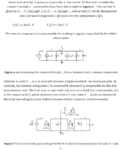Follow along with the video below to see how to install our site as a web app on your home screen.
Note: This feature may not be available in some browsers.
The reverse component Ir is responsible for making Cc appear magnified by the Miller effect when reflected to node V1 , so it is desirable because it helps establish the dominant pole.


The basic miller compensation circuit is build by connecting a capacitor across a gm cell. As explained very descriptively in the EDN link copied in post #3, it creates a wanted feedback action by current Ir and an unwanted feedforward action by current If.1. How Ir helps in miller compensation ?
2. Why block only If ?
"How Ir helps in miller compensation" - I'd say, Ir is the miller compensation.